第二章 形制奇异的茂陵陪葬墓 一、骠骑将军大司马霍去病墓
王志杰
1961年,国务院在公布第一批全国重点文物保护单位时,不仅茂陵作为西汉帝陵独列其中,茂陵陪葬墓中的霍去病墓,也在西汉帝陵数百座陪葬墓里独列其中。这就充分说明了茂陵及其陪葬墓的特殊性和重大的文物价值。
茂陵陪葬墓最新发现达50多座,经考古调查明确墓主身份的有李夫人墓、霍去病墓、卫青墓、霍光墓、阳信长公主墓、公孙弘墓、金日磾墓、上官桀墓等。这些陪葬墓的墓主,都是汉武帝生前的亲爱之人和近臣爱将,他(她)们死后能安葬在茂陵园区,也都是“君有所赐”,享受着特殊待遇。
无论是史籍所载,还是考古发现,茂陵陪葬墓大都具有特殊的形制。例如李夫人墓享受的是皇后葬制,霍光墓享受的是皇帝葬制,霍去病墓和卫青墓都造成代表其功勋的“名山”形制,这些特殊的形制。在其他西汉帝陵陪葬墓中是绝无仅有的。
一、骠骑将军大司马霍去病墓
——冢象祁连山。俗称“石岑子”。
霍去病(前140—前117年),河东平阳(今山西临汾西南)人,是大将军卫青的外甥。他的母亲卫少儿是汉武帝皇后卫子夫的二姐。卫少儿曾是汉武帝的姐姐平阳公主家里的奴婢,与平阳县衙役霍仲孺私通后,生下了霍去病。
霍去病从小生活在奴婢群中,生活十分艰苦。但他勤奋好学,小小年纪就精通了骑马、射箭、击刺等各种武艺。后来,卫子夫得宠,卫氏家族从此平步青云。到18岁时,霍去病已经成长为一个相貌奇伟、性格坚毅、智勇过人的青年。汉武帝很赏识他,任命他为侍中,经常跟随在武帝左右。
这时,霍去病的舅舅卫青几次领兵攻打匈奴,立下了赫赫战功。
元朔六年(前123年)春,汉武帝再次组织对匈奴的反击战争,年仅18岁的霍去病听说舅舅又要率军出征,便急不可待地向汉武帝请战。汉武帝见他少年英武,为了磨砺他,就答应了他的请求,任命他为骠姚校尉,跟随卫青出征匈奴,这是卫青第五次出征匈奴。
因为这是霍去病第一次参加真正的大战,卫青仅挑选了800名骁勇矫捷的骑兵归他指挥。虽然霍去病初次出征,但他胆识过人,率领着800骁骑,远离主力部队几百里,一往无前地向北冲去。莽莽草原,人迹全无。他们不知不觉地走了好几百里,将近黄昏,忽然发现前方远处有一片黑点。霍去病判断应是匈奴的营帐,当即命部下衔枚而行,以迅雷不及掩耳之势杀了过去。匈奴兵根本没想到汉军会这么远地杀来,顿时一片混乱。
霍去病身先士卒,首先闯入匈奴营帐,800骁骑个个勇猛无比,把匈奴兵杀得四散逃窜。这次战役,霍去病功居第一,其他各路有胜有负。卫青将战争的经过报告给了汉武帝。汉武帝对霍去病大加赞赏,说:“骠姚校尉霍去病,以800骁骑斩杀匈奴兵2028人,并杀死匈奴单于的祖父籍若侯产及相国、当户等将官多人,生擒单于的叔父罗姑比,出奇制胜,勇冠全军。赐封户2500户,封霍去病为冠军侯。”
公元前120年秋,匈奴骑兵万余人又突人定襄、右北平地区,杀掠汉朝边民1000多人。汉武帝决定远征漠北,彻底消灭匈奴军队。元狩四年(前119年),汉武帝调集10万骑兵,随军战马14万匹,步兵辎重部队几十万人,由卫青和霍去病各领5万骑兵,分东西两路向漠北进军。汉武帝原来的计划是由霍去病专力对付匈奴单于,所以给他配备的全是经过挑选的精兵强将。霍去病率军从代郡出发,在大沙漠地带纵横驰骋,行军2000多里,越过离侯山,渡过弓闾河,与匈奴左贤王相遇。汉军发动猛攻,左贤王大败而逃。这次战役,活捉匈奴屯头王、韩王等三人以及匈奴将军、相国、当户、都尉等83人,歼敌70433人。匈奴左贤王部几乎全军覆灭。霍去病率军追至狼居胥山(今蒙古境内德尔山)。为庆祝这次战役的胜利,霍去病在狠居胥山积土增山,举行祭天封礼,又在姑衍山(狼居胥山附近)举行祭地禅礼,并登临瀚海(今贝加尔湖),刻石纪功,然后凯旋还朝。与此同时,卫青大军也大获全胜。
霍去病因战功赫赫而被加封食邑5800户,并与大将军卫青一起被拜为大司马。
霍去病18岁率兵作战,先后六次讨伐匈奴,全获大胜,功勋卓著,不幸于公元前117年因病去世。武帝对霍去病英年早逝非常痛惜,为了表彰和纪念他的功勋,决定举行盛葬,并要把霍去病墓建在自己的陵寝旁,“为冢象祁连山”。就是说霍去病在“河西走廊”祁连山一带曾多次与匈奴作战,功高祁连山,所以要把他的墓冢建造得像祁连山一样高大。
霍去病墓,南北长101.5米,南宽56.7米,北宽58.4米,高18.38米,占地面积5841.33平方米,封土体积62961.24立方米。墓冢上下,乱石嶙峋,萋萋花草,苍松翠柏,荫蔽墓身,望之蔚然深幽而苍秀。墓南面东西两角,各有回栏曲径,通墓之顶端,人们可以循小径直登其上。
霍去病墓前巨型石刻,是中国历史上独一无二的西汉石刻艺术珍品。在17件石刻中,经国家文物局组织专家鉴定,列为“国宝”文物就有12件。
霍去病墓,历经2100多年的风雨洗礼,而今更显雄伟壮观。历代名人墨客,都曾经在此留下墨迹,称颂与弘扬霍去病的英雄主义和爱国主义精神。清代乾隆年间,陕西巡抚毕沅,为霍去病墓亲笔题书立碑——“汉骠骑将军大司马冠军侯霍公去病墓”。
在霍去病墓石刻群中有“马踏匈奴、起马、跃马、石人、人与熊、怪兽吃羊、野猪、蟾、蛙、石鱼(两件)、伏虎、卧牛、卧象、石刻文字“左司空”(两件)、“平原乐陵宿伯牙霍巨益”,共计17件。
In 1961 the State Council publicized the first batch list of key spots of interest for cultural relics to be protected.The Maoling Mausoleum was solely included among the counterparts of the Western Han Dynasty(206 B.C.-25 A.D.).Furthermore,the Tomb of Huo Qubing was only accepted among hundreds of subordinate tombs to emperor mausoleums of the Western Han Dynasty.The facts fully illustrate the specific characteristics of the Maoling Mausoleum and the satellite tombs and their vital values as cultural relics.
The latest discovery reveals that the satellite tombs at the Maoling Mausoleum have exceeded fifty.Archaeological survey has confirmed the identities of the tomb occupants including Madame Li,Huo Qubing,Wei Qing,Huo Guang,Princess Yangxin,Senior,Gongsun Hong,Jin Midi and Shangguan Jie.They were all favorites of Emperor Wudi before death-sweet-hearts,courtiers,nobles or commanders,who were consequently buried at the Maoling Mausoleum Area.
Both records in The Annals of Han History and archaeological discovery show that the satellite tombs at the Maoling Mausoleum mostly possess peculiar forms,e.g.,the tomb of Madame Li was built much like that of an empress,the tomb of Huo Guang was treated as that of an emperor,construction of the tombs of Huo Qubing and Wei Qing imitated a famed mountain to represent their military contribution.Those peculiar forms of satellite tombs no longer came into existence among subordinate counterparts to other emperor mausoleums of the Western Han Dynasty.
A Tomb of Huo Qubing,Cavary Commander & Great Minister of War
Huo Qubing(140-117B.C.),born at Pingyang County(southeast to Linfen,Shanxi),was a nephew of Wei Qing,commander-in-chief.His mother was the 2nd elder sister of Empress Wei Zifu,whom she served as waitress.She committed adultery with Huo Zhongru,an inferior official serving at Yamen(government office in feudal China)and gave birth to Huo Qubing.
Huo Qubing lived a hard life from childhood.Yet,he was diligent,eager to learn.When he was quite young,he mastered martial arts in horse ride,arrow shoot and sword thrust.Later,Wei Zifu became a favourite of the emperor.Consequently,the Wei's Family rose to fame.When Huo Qubing reached 18,he grew into a young man,who wore peculiar but magnificent appearance,possessed firm and persistent character and acquired unusual wisdom and bravery.The emperor spoke highly of him and appointed him to the post of Close Servant,ever ready to accompany the emperor.
By then,Wei Qing,Huo Qubing's uncle had commanded his troops to fight against the Hun invaders on many expeditions out and achieved brilliant military exploits.
In Spring of 6th year(123 B.C.)under the reign title of Yuanshuo(128-123 B.C.),Emperor Wudi organized a second attack on the Hun invaders.On hearing the news,Huo Qubing,aged 18,eagerly applied to the emperor for going to the front with his uncle.The emperor consented to his application and appointed him cavalry officer.That was 5th expedition out by Wei Qing to lead his army.
That was a real battle in which Huo Qubing would join 1st time in his lifetime.Wei Qing only singled out a vanguard of 800 valiant cavalrymen and arranged them under his command.Nevertheless,he led the 800 valiant cavalrymen north forward on the vast expense of grassland and spotted an army camp ahead at dusk.They went up stealthily and launched attacks at lightning speed on the invaders,who,bogged in chaos all of a sudden,did not even expect that an army from the Han had come before them from so far.
Huo Qubing and his 800 valiant cavalrymen fought valiantly and the enemy troops fled helter-skelter.The merits performed by Huo Qubing at the military campaign stood out in 1st place.The emperor conferred the title of Champion Marquis on him in praise of his wisdom and bravery.
In autumn of 120 B.C.,the Huns rode into the northern border again,where they killed over 1000 people and robbed wealth.Emperor Wudi decided to go on expedition out in hope of thorough annihilation of them.In 4th year(119 B.C.)of the reign title of Yuanshou,the emperor assembled one hundred thousand cavalrymen,one hundred and forty thousand warhorses plus hundreds of thousands of infantrymen to the front,Wei Qing and Huo Qubing each commanding the cavalrymen by half from eastern and western directions separately.Huo Qubing and his troops encountered obstinate resistance from the invaders but attacks from the Han army became more powerful and fiercer.As a result,their main forces were annihilated and their chieftains were captured alive.The large-scale campaign ended in splendid victory.Meantime,Wei Qing and his army also won brilliantly.
Huo Qubing and Wei Qing were thus honorably conferred the title of Great Minister of War.
Huo Qubing unfortunately died of illness at the age of 24 in 6th year(117 B.C.)under the reign title of Yuanshou.He had been dispatched on punitive expeditions out against the Hun invaders six times.Emperor Wudi felt very grieved over his death and issued a decree that a tomb be built by the side of the Maoling Mausoleum.In order to commemorate the military exploits Huo had performed on the northern and western borders in Gansu against the Huns,an extremely solemn ceremony was held when he was buried.His grave mound of natural stones was shaped into Mt.Qilian where he had swept the enemies.
The Tomb of Huo Qubing extends length of 101.5m north-south,width of 56.7m south and width of 58.4m north.It stands 18.38m high over an area of 5841.33 square meters.The grave mound takes 62961.24 cubic meters of rammed earth.The graveyard is shaded by pines and cypresses.To the south of the tomb are paved two paths leading to the tomb from east and west separately.
The huge stone sculptures before the Tomb of Huo Qubing are uniquely artistic treasures of the Western Han Dynasty.Among the 17 stone sculptures,relics of national treasures reach 12 after appraisal by experts from the State Cultural Relics Bureau.
The Tomb of Huo Qubing has withstood stress of weathers for more than 2100 years.Now the tomb looks majestic and magnificent all the more.Celebrities and men of letters have left their inscriptions in high praise of Huo Qubing's heroism and patriotism.Bi Yuan,Governor of Shaanxi during the reign of Emperor Qianlong(reigned 1736-1795)in the Qing Dynasty(1616-1911)personally wrote an inscription on the tombstone of Huo Qubing:
Tomb of hon.Huo Qubing,Cavalry Commander,Great Minister of War,Champion Marquis,Han
The stone sculptures at the graveyard of Huo Qubing include Hun Invader Hoofed by Warhorse,Horse Squatting for Action,Horse Ready to Leap,Stone Man,Man against Bear,Monster Preying on Sheep,Boar,Toad,Frog,Stone Fish(2 pieces),Tiger Squatting for Action,Ox Squatting at Leisure,Elephant Squatting at Leisure,Inscribed Characters of Memorial:‘zuo si kong’(2 pieces)and Inscribed Characters of Memorial:‘Su Boya,Huo juyi from Leling of Pingyuan’,all together 17 as many.
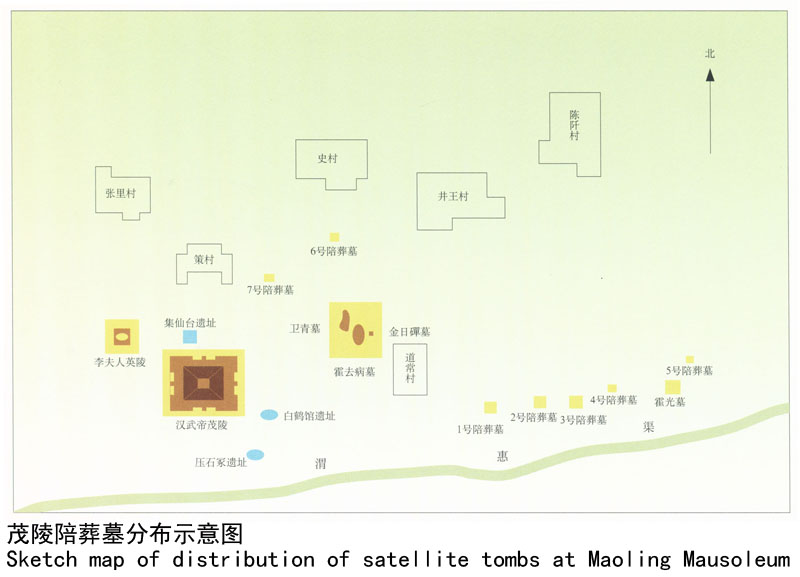
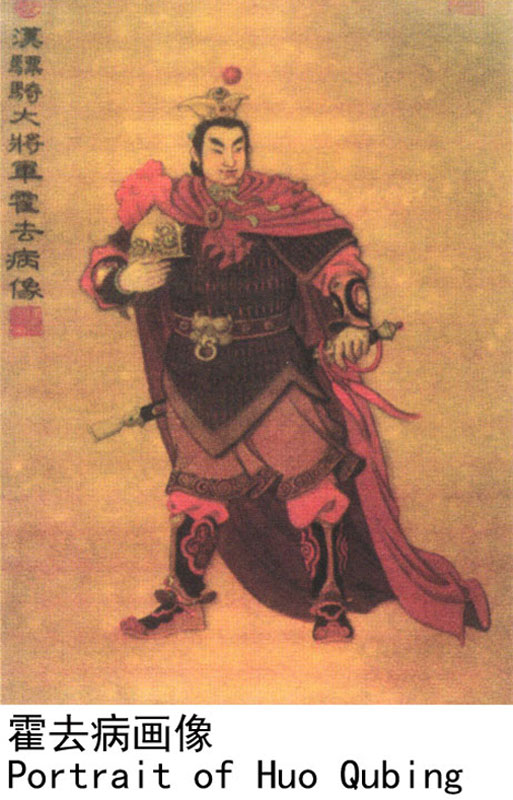
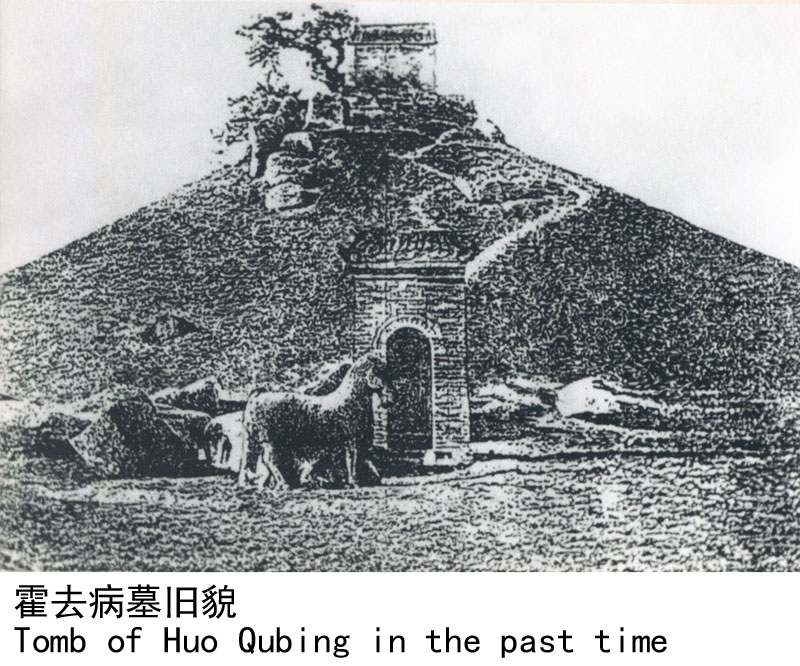
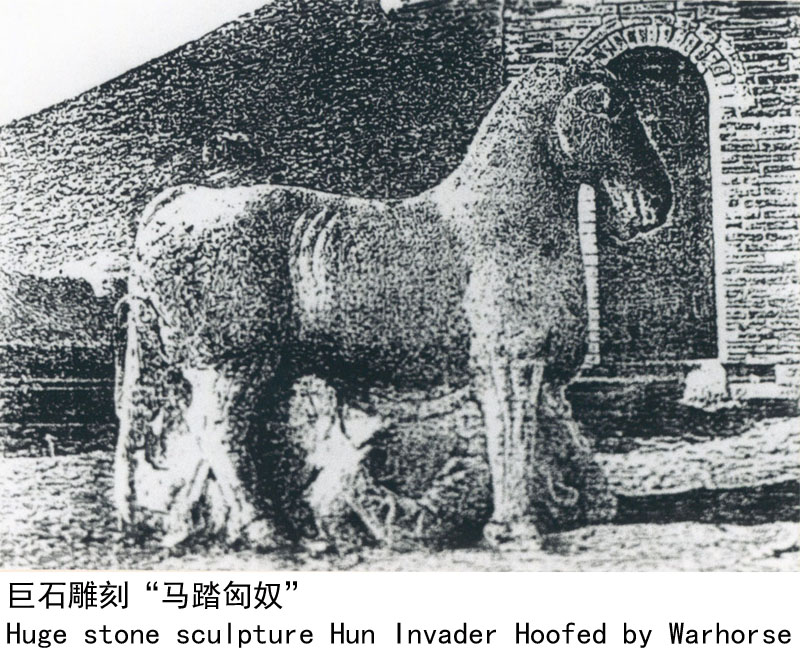
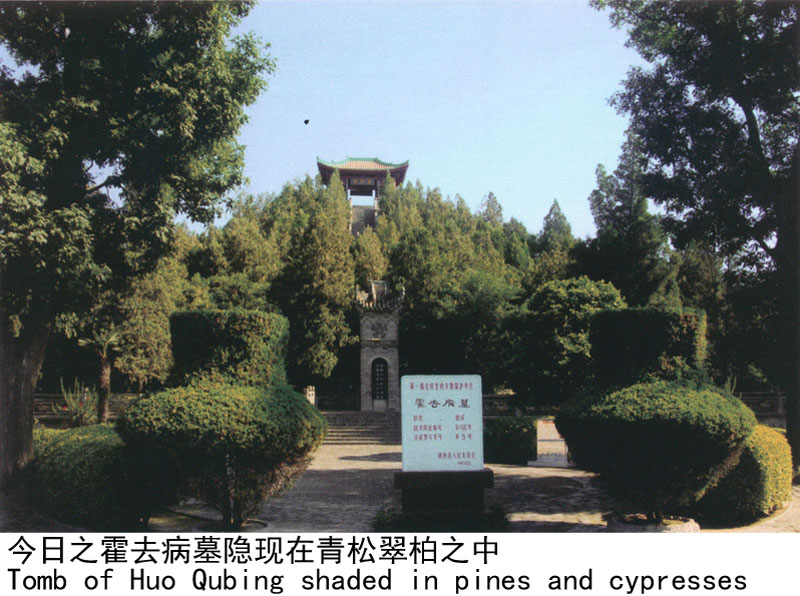
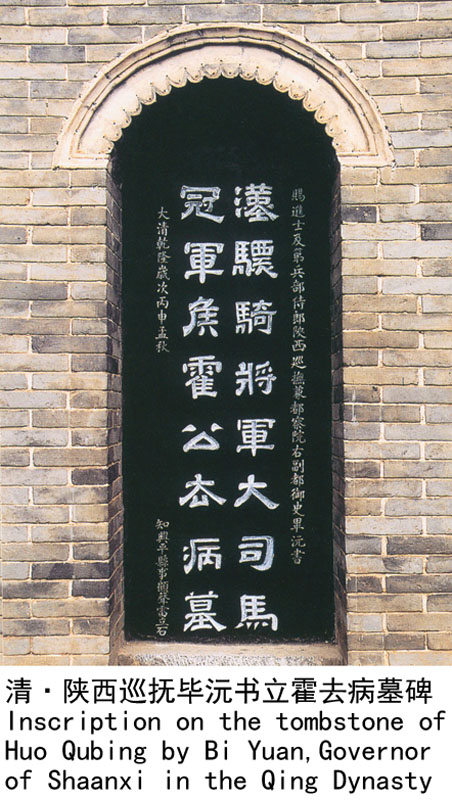
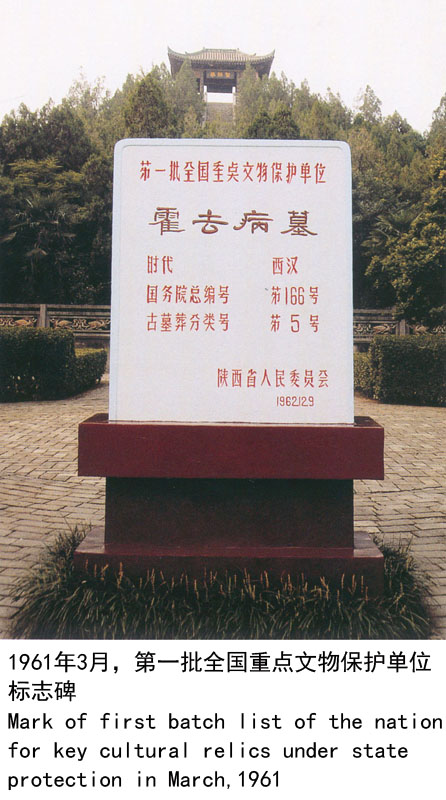
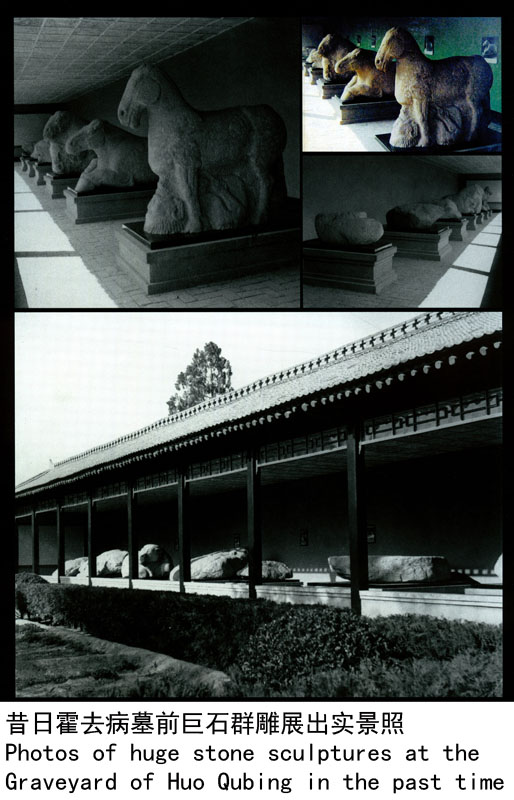
茂陵文物鉴赏图志/王志杰著.—西安:三秦出版社,2012.